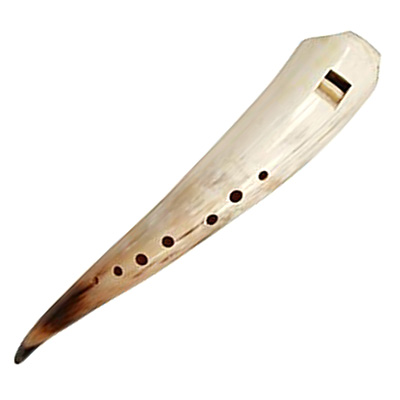 Gemshorn
Gemshorn
A kind of medieval recorder made from a cow's horn. The sound is soft, like a cross between a wooden flute and an ocarina.
The first clear illustration of the gemshorn is found in Virdung's Musica Getutscht (1511). By mid sixteenth century the instrument had fallen out of use. It has survived in the organ stop of the same name. The stop contains a strong fifth-sounding partial. They have been revived based on descriptions and pictures published in the 16th century.
The gemshorn is the only medieval flute with a sharply tapering conical bore. Its shape is determined naturally since it is made from the horn of a chamois or ox. The tone has a sweet color somewhere between a soft recorder and an ocarina. Its haunting delicate sound is even more impressive when one considers the ordinary material from which it is constructed. Shepherds probably used its gentle tones to calm animals.
It is impossible to produce an exact copy of a medieval gemshorn for two reasons — only a few unplayable instruments survive and there are only a few very vague drawings from 16th-century sources. There are no extant medieval depictions of gemshorns and no contemporary descriptions of them. The surviving specimens are unplayable and undated. (No. 3436 in the Musical Instrument Museum of the Staatliches Institut für Musickforschung in Berlin). Curt Sachs examined a gemshorn in the Bach-Haus at Eisenach back in 1913, but it has since disappeared.
An instrument found in 1908 currently in the Museo Nazionale di Arti e Tradizioni Popolari di Roma is unplayable. Another instrument found in the ground under a timbered house dated about 1455 was fired from clay. Both of these instruments have only four holes in the top, and one in the back.
Reconstructions by Andrew Parkinsonhave demonstrated that by building a Gemshorn with only four holes (one thumb hole and three front-lateral handle holes), it is possible to play an octave.
Herbert Myers suggests that the it was only of "peripheral" importance in the Middle Ages and was unlikely to have possessed the recorder-like fingering system given it by modern builders, and even less likely to have been built in families.
Other illustrations also show a horn with only four holes.
Modern makers bore seven holes in the front and one in the back. It makes sense to assume that instrument makers in antiquity would try to get the maximum number of notes possible from the instrument, and there are too few surviving descriptions to say with certainty that every gemshorn only had four holes. The body of the instrument is an animal horn with the cross-section of an oblate spheroid. Acoustically, there are only a few things you can do with this shape. By plugging one end and carving a lip, you get the fundamental tone of the instrument. Boring eight holes allows the player to get different notes, but only in the range of a ninth. It can't be overblown to get higher notes, so that's about it.

